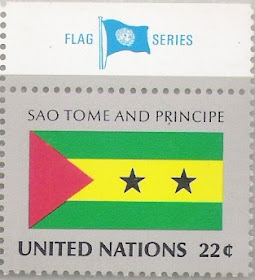Bangladesh celebrates “December 16” as “Victory
Day” (Bijôe Dibôsh) is a national holiday. On this day in 1971,
the Pakistani Army surrendered to the Indo-Bangladeshi High Command in Dhaka,
ending the 9 month-long Bangladesh Liberation War and 1971 Bangladesh
atrocities. Lt. General A.A.K. Niazi, Commanding Officer of the Pakistan Armed Forces of the then East Pakistan,
surrendered his forces to Lt. Gen J. Singh Arora, Commander of the Allied Forces.

The Instrument of Surrender was signed at Ramna Race Course in Dhaka on December 16, 1971, by Lt General J. S. Arora, General Officer Commanding in Chief of Eastern Command of the Indian Army and Lt. General A.A.K. Niazi, Commander of Pakistani Forces, as the formal act of surrender of all Pakistani Forces. Also present during the ceremony were Lt. General J.F.R. Jacob, Chief of Staff of the Eastern Command and architect of the plan for the capture of Bangladesh.

Issue Date: 29-07-1971
 The map was later deleted in 1972 from the flag. The red disc represents
the sun rising over the golden Bengal (Soner
Bangla), and also the blood of those who died for the independence of
Bangladesh. The green field stands for the lushness of the land of Bangladesh.
The map was later deleted in 1972 from the flag. The red disc represents
the sun rising over the golden Bengal (Soner
Bangla), and also the blood of those who died for the independence of
Bangladesh. The green field stands for the lushness of the land of Bangladesh.

The Instrument of Surrender was signed at Ramna Race Course in Dhaka on December 16, 1971, by Lt General J. S. Arora, General Officer Commanding in Chief of Eastern Command of the Indian Army and Lt. General A.A.K. Niazi, Commander of Pakistani Forces, as the formal act of surrender of all Pakistani Forces. Also present during the ceremony were Lt. General J.F.R. Jacob, Chief of Staff of the Eastern Command and architect of the plan for the capture of Bangladesh.

Designer: Biman Mallik
Printer: Format International Printing Press,
U.K.
The flag of Bangladesh used during the Bangladesh Liberation War of
1971.
 The map was later deleted in 1972 from the flag. The red disc represents
the sun rising over the golden Bengal (Soner
Bangla), and also the blood of those who died for the independence of
Bangladesh. The green field stands for the lushness of the land of Bangladesh.
The map was later deleted in 1972 from the flag. The red disc represents
the sun rising over the golden Bengal (Soner
Bangla), and also the blood of those who died for the independence of
Bangladesh. The green field stands for the lushness of the land of Bangladesh.
Indian stamp issued on 10 April 1973, in commemoration of the inauguration of the first Parliament on 26-3-1971, gave itself a constitution on 16 December 1972. The stamp shows its National Flag with the Shapla - the National Flower of Bangladesh.
Note the typical perforation shift only at the left bottom corner
India
also commemorates victory over Pakistan on the same day in 1971 as Vijay
Divas on 16 December.
Amar Shonar Bangla (My Golden Bengal) - the National Anthem of Bangladesh was written and composed by Rabindranath Tagore in 1905.










































